|
Film commentary is littered with absolutes and extremes of praise and damnation. Even the most learned journals fall prey to overstatement and occasionally trip up over their understandable enthusiasm – just recently in Sight & Sound, Henry K. Miller described David Fincher and Aaron Sorkin's Facebook drama The Social Network as "a classic." Now according to my dictionary, the term 'classic' describes a work that is "judged over a period of time to be of the highest quality and outstanding of its kind," and when they say "over a period of time" I presume they're not talking about the day or so that passed between seeing the film a writing about it. Which is why, of course, the currently popular (and infuriating) term "instant classic" is blatantly oxymoronic.
A favourite such term bandied about when discussing science fiction cinema is 'visionary'. It makes sense, of course, seeing as science fiction is generally forward-looking and making educated guesses about our future, and when writers or filmmakers get it even partially right then visionary is the term that best fits. Quite a few sf films have been called visionary over the years, 2001: A Space Odyssey, Alien and Blade Runner among them, and I have no problem with that, as all three feature astonishingly credible future worlds and technology. But they were also products of the upper end of the twentieth century and had decades of past science fiction cinema and literature to draw on. So how to you appropriately classify a genre film made back in 1927 that's as epic and forward-looking as anything made since?
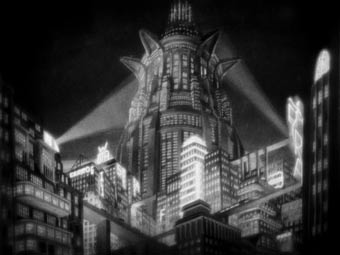
Directed by Fritz Lang, who was no stranger to innovation, Metropolis is to science fiction what Nosferatu is to vampire movies, the first major work in a film genre that had yet to be officially recognised as such (that both were the products of a hugely fertle period in German cinema history is perhaps a subject for a seperate discussion). And yes it is visionary and in more than its technology, but it's also a social drama with a political message, one that builds to a climactic flood that prefigures the disaster movies of the 1970s. On the surface, it's a story of class division at its most extreme. In the technologically and architecturally advanced city of Metropolis, society is divided into two distinct classes: an overworked drone-like proletariat, who live and work underground and operate the machinery that maintains the city's infrastructure, and the prosperous bourgeoisie, who live comfortably above ground and whose offspring fritter away their time on leisure activities. The city's founder and master is the cheerless Joh Fredersen, whose son Freder's carefree life and ignorance of the underworld is shattered when the beautiful Maria, a saintly prophet from the city of workers, brings a group of bedraggled children to the surface so that those who dwell there might meet those who toil in their name. Entranced by Maria's beauty, Freder ventures below to the cathedral-like machine houses, where he is shaken by an accident that that leaves many workers seriously injured. He later returns and exchanges places with an exhausted machine operator, and at the end of his shift attends a secret meeting in which Maria preaches a message of brotherhood and unity. When he learns of Maria's words and her hold on the workforce, Fredersen orders inventor Rotwang to shape his latest creation – an automaton able to pass convincingly as a human – in the image of Maria to incite rebellion and provide him with an excuse to take extreme measures against the workers.
There's no question that, if taken literally, much of Metropolis doesn't make complete sense. Fredersen in particular seems indifferent to the fact that the rebellion he wants to inspire will result in the destruction of the machines that keep his city alive, while the workers, once roused, seem to switch their allegiance at the drop of a hat and charge off to revolution without a thought for their children, at least until the consequences of their actions place the young ones in peril. But it becomes increasingly clear that Lang is not telling his story literally but in symbolic shorthand, which although can prove simplistic and deny his characters depth, does vividly capture the subjective essence of an experience. A prime example can be found in the opening scene, as an army of uniformed workers, their heads wearily lowered, trudge in robotic unison to and from their daily toil. Some have seen this as bordering on caricature, but having myself worked long hours in a factory for miserable wages, I've always felt that this sequence captures exactly what it felt like to go into work there each day, a perfect illustration of grey drudgery and the suppression of individuality that often comes with such toil.* It's the same with the machine operators who robotically move levers that have no obvious purpose, actions that precisely capture the monotony of production line work, where operators were once condemned to repeat the same action over and over, tasks that are now carried out by machines that require only the minimum of human supervision to function.
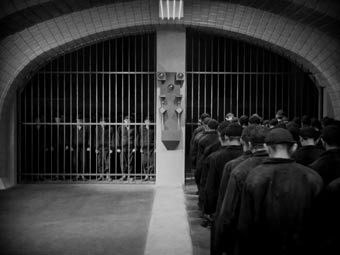
An expressionistic eye is also required to make sense of the presentation of Maria as the impossibly saintly figure who chairs the underground meeting. Standing on a pedestal against a background of towering crucifixes, she's less like a prophet than an artistic rendition of an angel in human form, which is exactly how she appears to those who flock to her meetings, the oppressed and the downtrodden for whom she is the sole symbol of hope. Elsewhere, Lang and co-writer Thea von Harbou (to whom Lang was then married) compress entire sequences down to the key points of plot development, ones that given more screen time could comfortably have been expanded into complex stories of their own. Hence the speed with which Freder is transformed from a carefree playboy into an industrious friend of the working man, or the seemingly impossible ease with which the workers are led to destructive riot, child abandonment, and a willingness to execute a woman without trial. Many of the performances are similarly expressionistic, with extremes of emotion externalised with sometimes pantomime passion (the mere mention of the film prompted fellow reviewer Camus to adopt a pose from a famous production still in which a wild-faced Rotwang is excitedly raising his false hand). Although much of this feels dated, it finds a perfect home in the physically explosive expressiveness of the Robot Maria, and is at one point unexpectedly tempered by the matter-of-fact manner with which Rotwang operates the identity transfer machinery, much like a real scientist would behave if caught up in the mechanics of a complex process.
This portrait of an oppressed and exploited underground workforce, who meet in secret and rise up against the wealthy city masters, prompted some on its original release to read it as Marxist cinema, and there's no question that politically this is coming from the left. Underlying the drama is an open criticism of a system in which the rich prosper uncaringly through the hardship and toil of the workers, one that could almost be interpreted as a warning of the consequences of inequality and indifference to the suffering of those on whose backs the city and its wealth were built. George Osborne and his cronies would do well to take note. So great is the division here between management and workforce that Fredersen only learns of the above-mentioned industrial accident though a shop floor informant, and even then takes no action to remedy the situation that led to it. But Lang and his co-writer von Harbou are not advocating revolution but pleading for a middle ground in which management and workers can communicate and work together, a view epitomised in the film's climactic (and critically derided) claim that the the head and the hand can be united through the heart.
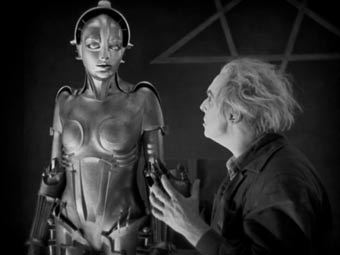
It's long been acknowledged that Lang and his collaborators borrowed from H.G. Welles (his 1910 novel When the Sleeper Awakes is a frequently quoted influence), who in turn expressed his open contempt for the film, writing in the New York Times that it "gives in one eddying concentration almost every possible foolishness, cliché, platitude, and muddlement about mechanical progress and progress in general served up with a sauce of sentimentality that is all its own." Ouch. But the passing of time has shown much of the film to be prophetic in its vision, from machinery on the scale you'll find turbine driven power plants to workstations monitored by CCTV, and awe-inspiring cityscapes whose densely packed skyscrapers and elevated roadways that would not look out of place in any major industrialised city from Chicago to Dubai. The strong religious overtones doubtless grew from Lang's own Catholicism (Catholic imagery made its way into several of his films), while contemporary art movements – particularly Modernism and Art Deco – were clearly influential on the design. And then there's Rotwang's man-machine, a fabulously designed automaton that, instead of twitching about about jerkily in the manner of so many of the genre films that followed, moves slowly and smoothly as if operated by hydraulics. Sound familiar? That the machine's creator is just about the best mad scientist in movie history is a bonus.
The special effects still impress today, a remarkable blend of model shots, animation and a technique known as the Schüfftan Process, in which mirrors were used to place actors in model work in a manner that prefigures the pioneering matte work in 2001: A Space Odyssey. Equally striking, and every bit as complex, are the broken-mirror montage shots that play like dadaist artworks in motion (ones that were created exclusively in camera), and a brief but extraordinary explosion of rapid-fire editing and avant-garde imagery that may well count as one of the first widely seen examples of experimental cinema.
So in spite of its over-expressive acting, its shorthand plotting, and its over-simplification, Metropolis fully justifies its acclaim as one of the key works of both science fiction and German Expressionist cinema and remains one of the most widely seen and influential films from the silent era. I'm not about to start reeling off the films, music videos, novels and even songs the film has left its mark on, but you won't have to look far for examples, from the cityscapes of Blade Runner to the design of C3PO from Star Wars, and fans of German electro-band Kraftwerk will recognise Rotwang's term Man-Machine as the title of one of the group's most popular albums, which also included a track titled Metropolis. Such is the film's legacy that it continues to feature prominently in favourite film polls, whether they be of science fiction cinema or movies in general, and over eighty years after it was first released, it still ranks #95 in the IMDb top 250 and came in at #12 in Empire's 100 Best Films of World Cinema earlier this year. Visionary? I should say so.
I'm assuming that a good many of you are aware of the film's chequered history and the reasons for this new release, but I'll quickly summarise the essentials for newcomers. Metropolis is generally thought to have been the most expensive silent film ever made, costing an estimated 6 million Reichsmark (which has been approximated at over $200 million in today's money), only a fraction of which it recouped at the German box-office. The original cut ran for 153 minutes, but with many foreign markets unwilling to screen a film of this length, the running time was severely shorted, with the American edit (carried out by playwright Channing Pollock) coming in at just 114 minutes. The domestic print was also re-edited to bring it in line with the overseas versions, and in one of those tragedies of film history, the excised footage was somehow disposed of and was considered forever lost.
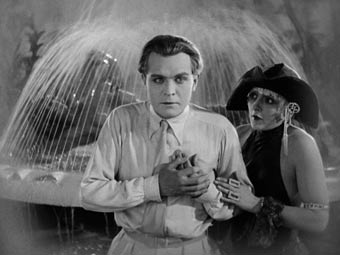
Over the years, the film has been released in a range of edits of varying length and accompanied by a variety of music scores. Perhaps the most famous – or perhaps notorious – was the 1984 version by composer Georgio Moroder, which cut the film down to 87 minutes, colour tinted the visuals, and filled the soundtrack with the sort of pop hits that prompt rock fans to shudder when you mention the 80s. It certainly brought the film more widespread attention and it definitely has its fans, but I've never been one of them.
In 2002, restoration specialists Friedrich-Wilhelm-Murnau-Stiftung, in collaboration with Kino International, released a digital restoration that ran for 124 minutes to mark the film's 75th anniversary, which was accompanied by a new recording of the original Gottfried Huppertz music score and incorporated title cards to outline the still missing sequences. Then in 2008, a 16mm reduction negative was discovered in Argentina, one that contained almost all of the footage that had been previously thought lost. A New Zealand print also provided a few more precious seconds of footage still missing from this version. Unfortunately, the 16mm negative was in an extremely poor state and the picture had been cropped from the original 35mm framing. Careful restoration work was required to stabilise the picture and repair some of the damage, a process that could only be taken so far without compromising the original image.
The version presented here was assembled and restored by the fine people at Friedrich-Wilhelm-Murnau-Stiftung and Deutsche Kinemathek, and represents the most complete edit of the film since its Berlin release back in 1927. The damaged 16mm footage has been used where no 35mm material exists, and black leader and title cards have been inserted to mark the few places where there is still no useable footage.
Much of the restored material consists of single additional shots in existing scenes, adding reactions, extending encounters, and making subtle but sometimes significant changes to the rhythm, clarity and even dramatic weight of the sequence in question. The night club fight that the Robot Maria provokes now escalates to a shooting, while Freder's feverish reaction to the Robot Maria's first performance (which he does not witness) is now revealed instead to be a vision of his father's assistant at the end of his bed making predictions of the apocalypse. There are some stand-alone shots of real significance, notably one in which Rotwang sits at the feet of the Man-Machine and talks of annihilating Fredersen and his city and son, while his motivation for wanting to do so is clarified by footage that emphasises the true scale of his obsession with past love Hel, whom he lost to Fredersen and who died giving birth to Freder. The expansion of the film's first meeting between the two men gives both characters more depth, with Fredersen's regret and sadness at his loss providing a possible reason for the cold-hearted and ruthless industrialist he has since become.
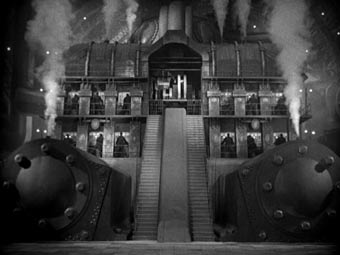
Perhaps the most substantial additional material involves a character identified in the cast only as The Thin Man, who functions as Fredersen's assistant and in the cut-down version was little more than a clerical dogsbody who followed his master around and took care of business chores. In the restored print, he has the more significant role of a corporate goon, charged with shadowing Freder and recording his movements, and financially persuading or leaning on those who threaten to upset his employer's version of the status quo. This overlaps with another significant piece of character expansion in which the machine operator that Freder swaps places with becomes quickly seduced by the opportunities for hedonistic pleasure that wealth and privilege bring, and instead of meeting dismissed manager Josaphat as requested by Freder, has his chauffeur drive him to a club where the sons of the wealthy leave all morality at the door. An interesting aside is that the club's name is Yoshiwara, which those with a little knowledge of Japanese history will recognise as a famous and centuries-old Tokyo red light district.
As outlined above, the HD master that has been used for this transfer has been constructed from a combination of carefully restored 35mm material and the rediscovered 16mm reduction negative, which leading film restorer Martin Koerber describes in the accompanying documentary as "the worst material I have ever seen in my entire life – I have never seen such a badly damaged film before." Pristine it is thus not destined to look. But this matters not, as while a consistently perfect print would be lovely to see, being able to so easily identify the restored shots and scenes has its own cineaste pleasure, and a quick look at the untreated shots included in the documentary illustrates just how much work has gone into pulling this footage back from the brink. Although it retains much of the damage and is noticeably less detailed than its 35mm bedfellow, the image itself is reasonably clear, with frame jitter stabilised and inconsistencies in image brightness minimised, though detail has been lost at both ends of the contrast range. Rather than lose picture information by enlarging the shots to fill the 1.33:1 screen, the missing picture information is represented by black bar at the top and side of the picture where the image has been cropped in the transfer to 16mm.
The 35mm material is a different matter. Metropolis has appeared in more versions than any other silent film I can think of – one of my VHS copies was even given away free on the front of a film magazine, suggesting that for a period it was even out of copyright. None of them looked great, but for many years this was par for the silent film course. But recently the image of silent cinema as inevitably scratched, dust-covered, jittery and unevenly exposed has been turned on its head by increasingly sophisticated software and the hard work of a skilled and dedicated restoration houses.
|
|
The newly discovered (and seriously damaged) 16mm reduction negative
material (left) and the restored 35mm material (right)
|
|
One of the shining lights of the restoration world is the team at Friedrich-Wilhelm-Murnau-Stiftung, who not so long ago did the near-impossible by transforming the tattered Nosferatu into an object of cinematic beauty. Here they have worked with Deutsche Kinemathek to perform a similar miracle on Metropolis, and the results, considering the film's age and the condition of the pre-2002 prints, are extraordinary. Gone is any trace of frame jump or jitter, gone are multiple tramlines of scratches, gone is the dust and serious damage, and although still clearly visible, the flickering variances in brightness have been considerably reduced. The contrast is for the most part absolutely spot on, but the real surprise – and what makes me want to get my hands on the Blu-ray – is a level of picture detail that goes visibly beyond any previous tape or DVD version. It comes as no surprise that there is some variance here – a number of source prints were used for the restoration – but the best material is a treat for the eyes and genuinely transforms the experience of watching the film. Now it really does feel like the epic vision it was always intended to be.
Gottfried Huppertz's original score is performed by the Rundfunk-Sinfonieorchester of Berlin and conducted by Frank Strobel, and has been transferred to the DVD in Dolby 2.0 stereo. As you'd expect from a newly recorded musical soundtrack, it sounds impressive, boasting a fine range and clarity and distinct separation across the front sound stage, though I suspect that the uncompressed (and apparently 5.1) Blu-ray equivalent will knock this firmly into second place.
Kalat/Rosenbaum Commentary
So-called 'expert' commentaries can sometimes be hard work, but film writer David Kalat has already proved himself to be an enthralling communicator who knows his subject inside-out (check out his excellent commentaries on Eureka's Dr. Mabuse box set), and he doesn't disappoint here. He's joined by fellow writer Jonathan Rosenbaum, who proves every bit as knowledgeable, and despite his more growling delivery style is an equal enthusiast for the film. The two men bounce off each other well and a huge amount of ground is covered, with screen-specific commentary on the action, composition, making and reading of specific scenes interspersed with information on Lang and von Harbou, the film's production and subsequent influences, the reconstruction process, Lang's early solo screenplay, the crew and cast, the filmmaking, the effects, von Harbou's novel, the influence of German Expressionism, subsequent critical readings, its socio-political longevity and a good deal more. An essential companion to the film, my only complaint is that the the two men sometimes struggle to be clearly heard over the score, which plays a little too loudly in the background.
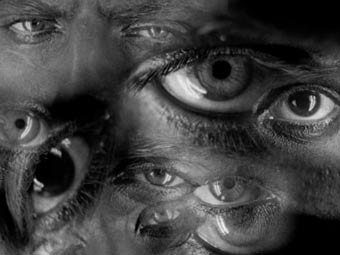
2010 Trailer (2:01)
A trailer for this reconstructed and remastered version that's of the same quality as the film itself. I'd certainly want to see it after watching this.
Die Reise nach Metropolis
Produced in Germany for Transit Film and the Friedrich-Wilhelm-Murnau-Stiftung, this fascinating documentary looks at the film, its history and its restoration, and includes interviews with many of the key figures involved with bringing this near-complete version to the screen, plus some archive interviews with Lang himself. Convincing evidence is provided of a very specific influence on the Blade Runner skyline, and Lang offers an interesting re-evaluation of an ending even he was initially unsure of. My only small gripe is that older 4:3 material has been cropped to fill the 16:9 frame, but the picture quality on the newly filmed material is stunning even on DVD.
Booklet
There's almost a sense that I could cut and paste my enthusiasm for the booklets that accompany Masters of Cinema releases, and the one here is well up to their own high-set standards. Nestled between its covers is a detailed examination of the film by Jonathan Rosenbaum, a short but useful 1927 piece by Fritz Lang on its writing and production, a fascinating 1927 review by Luis Buñuel, an informative and detailed Sight & Sound article on the film's history and reconstruction by Karen Naundorf, details of the restoration and reconstruction by film restorer Martin Koerber, poster reproductions, some lovely stills, and credits for both the film and the restoration.
For all the retrospective nitpicking about simplistic storytelling, Metropolis stands today as one of those great works of silent cinema that continue to tower over the genre they effectively gave birth to. Visually it's still a stunner, and while Jonathan Rosenbaum in his otherwise excellent essay oblique criticises the film's 'naïve' socialism, it provides a neat cinematic précis of the ongoing problem of industrial class struggle, and with the current resurgence of the conservative right and widening divisions between the super-rich and the poor, it's one that may once again prove the cause of potentially damaging conflict.
Everyone who really cares about film should own a copy of Metropolis in one form or other, and as far as I'm concerned this is the version you should forsake all others for, for the near completeness of the edit, for the fabulous restoration, for the information-packed commentary, for the excellent documentary, and for a booklet whose every page makes for fascinating reading. I'll go out on a limb and suggest the Blu-ray is the one to go for, for the increased resolution and the uncompressed music track, but if you've not made the HD jump yet then you'll not feel in any way short-changed by the DVD. Either way, you have to get this disc. Highly recommended.
|